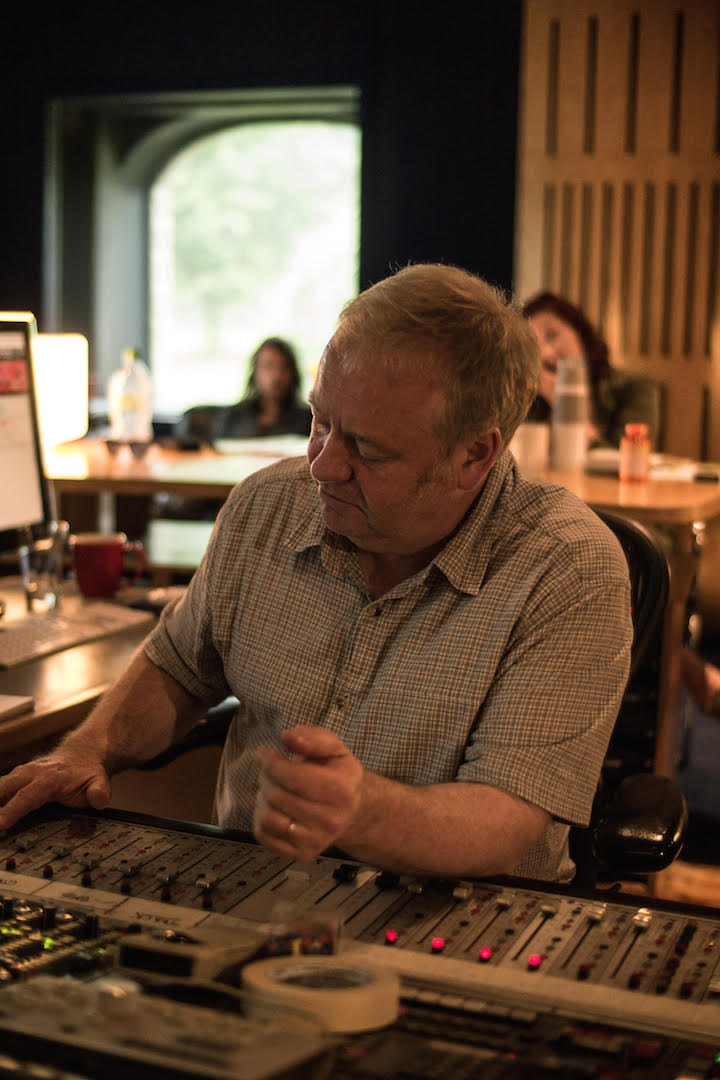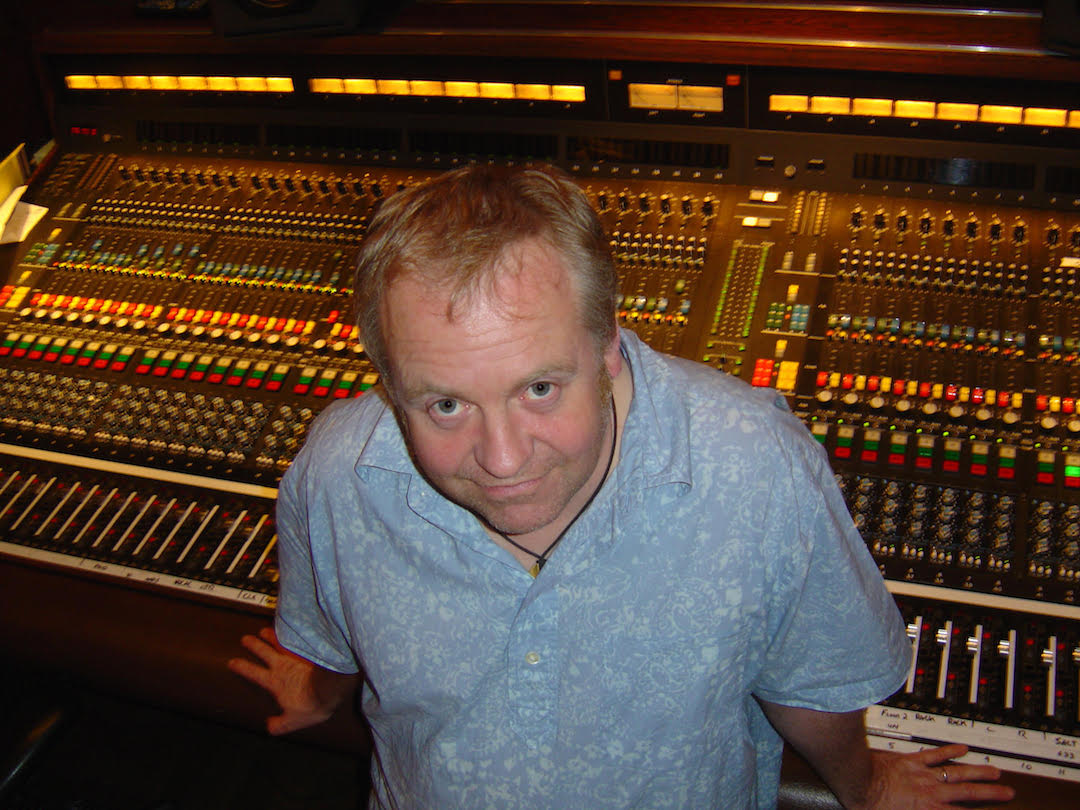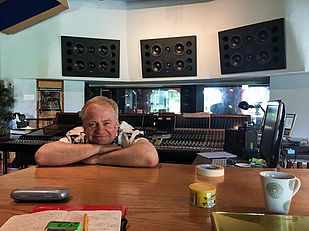Cameron Craig: An Aussie in the UK Engineering for Adele, Amy Winehouse, Suzanne Vega, UNKLE & More

Cameron Craig, pictured here at Neve console, has become just as at home working in the UK as in his native Australia, and just as comfortable in the box as on a big board.
Cameron Craig has worked in the UK since the 1990s, when he moved from Australia to pursue his dream of working in the then-burgeoning Brit-pop scene.
There, he moved up the ladder in the music industry, developing the connections that led him to work with artists including Adele, Amy Winehouse, UNKLE and eventually, earn himself two GRAMMY Awards.
Since more and more mixing takes place on the computer nowadays, Craig has adapted his workflow from a reliance on big analog consoles to the in-the-box and hybrid approaches he uses today.
When we spoke, he outlined his approach to 21st century mixing, from his thoughts on mix templates to the importance of understanding the emotion the artist wants to get across in their work.
Craig is also is heavily involved with the Music Producers Guild, an organization producers can turn to for a variety of issues, and shared what he believes to be some of their most important initiatives.
I hope you enjoy this interview as much as I did, and am certain that you will find some useful ideas that you can apply to your own work.
You moved to the UK in the 90s from Australia. What were some of your biggest struggles getting started in the music business in the UK?
It was quite hard, I didn’t know anyone. I had a very good run in Australia, but the Brit-pop scene that was happening at the time seemed very exciting. I would read articles with English producers thinking that their thought process for making records was so similar to mine and I wanted to be a part of it, so decided to move.
Not for one second did it dawn on me that I wasn’t English! When I got here I would be talking with people and I always got the same question, “Have you worked with Kylie?…No“, “Have you worked with Nick Cave?…No“, “Have you worked with INXS?…No” and that was usually the end of the conversation.
How did you make some of your first breakthroughs there?
When I came over to the UK, a friend of mine from Australia, who was also in England at the time, had a manager and they had organized some studio time for him, which I engineered.
When I went back to collect the tapes, the owner was there and we got into a conversation. That led to me working there as a freelance in-house engineer.
They also did a lot of work for Island Records which led to filling in at the Fallout Shelter Studio. Through the same management, I met someone that was connected with Chiswick Reach Studios, which was this little valve studio in Chiswick.
There, I had to rethink how I recorded things as it was a very different approach but I got to meet a lot of like-minded people. This was the place where I first started working with James Lavelle which got things moving for my career and a 20-year working relationship with James.
The next step came from a company that was moving studio gear around. One of the drivers, whose band I was recording at the time, told me about this studio called 2kHz which had an EMI TG desk. I had hired the EMI TG desk to use at Milo Studios through a Chiswick Reach client and I thought it was—and still do—one of the best desks so I went to check it out.
I think I was one of the first sessions there. They were still putting the finishing touches on the place and on that first session there was still fiberglass in the corridor we had to jump over to get into the live room. I loved it. Met loads of people and made some great records there.
After that initial session, the manager got me in for what started as, “Can you record some drums for a few hours?” That turned into a relationship that is still going today.
What’s the biggest difference in the recording industry between then and now?
It’s very different, but also the same.
Then, you would start a project and see them through over a longer period of time. As soon as computers came into the equation, it started getting broken up into smaller bits.
Its to the point now where I will do a tracking session and it will go off to its respective places where people will work on it a little bit more. After that, it will come back to me for mixing and I will sit in a room like this on my own to mix it.
Even a lot of my local clients don’t bother to come in for mixing anymore. It’s not that they don’t care, they just don’t have to anymore.
How would you have done it in the past?
In the past, if you were mixing a track you would have to get it done that day. You would go to the studio and start mixing, and by the end of the day, you would be done. Any changes afterwards would mean a re-call, so it was a much bigger and longer process.
The last big analog mixes for me were in the mid-2000s, but then sessions could take forever, because once we all agreed it was great, it took another day to put it down, make stems and all the things that needed doing.
It was usually too expensive to have to come back to it, spend 3 hours or so recalling it, make your changes and reprint it all over again. It made you a better engineer, but I’m not sure that it ultimately led to better mixes in a way because you had to get it done. You didn’t really get a chance to come back to things that often, and things were often left a little bit unfinished-sounding to me.
I’m glad I started in that world and have that knowledge to draw from. But now, with the sort of clients I have, you can make sure that it’s right before it goes out which is a much better scenario for me.
You’ve gone on to work with a lot of bigger artists. Can you tell us how you developed those connections?
A lot of it was through those original connections, where a group of friends went on to become very successful. Jimmy Hogarth, who did the Amy Winehouse track, [“Help Yourself”], shared studio space with me, so I ended up mixing it.
It was just one of those tracks where he asked, “Do you want to mix this?”, “Yeah, alright”. So we mixed it. Did half in my room and finished it off in his room. We were literally 15 feet apart. I still work with Jimmy to this day.
The first Grammy was for Suzanne Vega [Beauty & Crime] which Jimmy produced as well. Sam Dixon, who wrote and played bass on the Sia record, also produced by Jimmy, went off to tour with Adele and wrote a track that ended up on her album 25. That’s how I ended up working on that album.
Annie Lennox was through State of the Ark Studios, which recommended me to producer Mike Stevens. Unfortunately, we lost out to Lady Gaga and Tony Bennett at the GRAMMYs with that one.
How do you prepare for mixing a song or an album? Do you have a routine or a specific workflow you like to use?
A little bit, but not really. Every album is different, so I don’t like getting into that, “I do it this way and this is the way its got to be done”.
With some projects, bits and pieces come from everywhere and it’s a matter of assembling it and putting it all together. I get it to the point where I’m happy and then present it to the artist and wait for feedback.
The UNKLE album was made very much like that. With some songs, there were loads of bits coming from all over the place so I had to compile it and figure out how it all worked together before I could even think about mixing it. Others tracks were quite well prepared and different songs required different approaches
Some albums will come to you and they want a certain sound, so I’ll work it up a bit in the box but then we will have to go a studio to run it through the desk because it needs that sound. It’s dependent on the project, where we will end up doing it, and what is best for the project, as opposed to my specific workflow.
I don’t even have templates. By the end of an album I will have one, but at the start of the record, I won’t stick to a specific template. I will always start by thinking of what the song needs and start creating a template as the album progresses and which sonic ideas works. By the end, a collection of common sounds will emerge and I will have a template down, but then I won’t need to use it again as every album is different.
Do you try to find the emotional aspect before you start thinking about templates?
Yes, very much so. For me, that’s what it’s all about. There’s no secret sound—it’s about finding a balance that expresses the emotion that the artist is trying to get across. Next [comes] the sonics to make that happen.
Usually, you get all your files in, do a quick balance to listen to it, and check the description of what they are trying to achieve. You might go, “Well, this is not going to work sonically to get across that emotion.” Then, I will have to do whatever I have to do to make that happen.
For example, with the Annie Lennox record, the producer had mixed it and wasn’t quite happy with what it was doing. We organized a day to do a mix together to see how we get on. After about two hours we just looked at each other and realized it was going to work. We then started talking about the record and decided that some of the instruments were the issue. A lot of the drums were programmed so we got a drummer and a double bass player in and recorded most of it in a day.
That was one that, sonically, needed to go through a desk to get some color into it because it had all been done in the box at that point. We used one of my favorite desks, the EMI TG. On some tracks, the mixes were very different from the producer’s mixes and others were quite similar. It’s whatever it takes to get the emotion across.
Do you mainly talk to the band to understand the emotion they want to get across? Or do you do it by listening to their music?
I like to talk to people beforehand. It’s not necessarily asking what they want it to sound like, but you talk to them and you can start to figure out what they want from their music.
You said you love the EMI TG. Do you have a preference, working fully analogue, hybrid or in-the-box?
I do in-the-box if that’s what’s required. I don’t do fully analog anymore because there is so much that the computer is good for. But hybrid is the best of both worlds, which I’ve used for a while now.
What do you feel you are gaining by going out to a console?
It’s hard to describe, but sometimes you just can’t get the feeling you want from an in-the-box mix. Sometimes, it’s psychological, and from an artist point of view, they like to use a desk.
Sonically, I like consoles with a lot of color, like the EMI TG, 80-series Neve and desks along those lines, because usually if I’m going to a studio it’s because the recordings are a bit flat from being recorded to the computer or through a bad interface. You can do it in the box nowadays, but it’s not the same and it takes a lot longer than just putting it through a desk.
What do you think is the role of gear in getting the sounds you want?
For recording, gear is part of it. It’s about having a sonic palette that you know in your mind. If someone asks for something to sound a certain way, you know how to get it because you know what gear imparts what sound.
Over the years, you should build up a mental collection of those sounds so if somebody asks for a sound you can get it quite quickly.
Having the tools to hand is what helps that process so you can go, “this microphone with this pre-amp and that compressor gives you that sound and another microphone gives that other sound.”
You have been involved with the Music Producers Guild for a while now. Could you tell us a bit more about your work there and how what kind of impact you think it has on the music industry?
The music producers guild is a guild, not a union or anything like that, and sometimes we joke that it’s a giant self-help group. [Laughs].
If an MPG member has got an issue that is producer-related, we have the mechanism and the means to get that heard and hopefully dealt with.
Olga Fitzroy came to us with the shared parental leave campaign which you can get if you are employed, but not self-employed, which most of our industry is. It seems like a contributing factor that makes it harder for women to stay in the industry. Olga had at first been running a Facebook campaign, then she came to us and asked if we could help. We said, “Yes” and took it to UK Music and asked if they thought it could fly. They also said, “Yes”, so they got involved and it ended up in Labour’s election manifesto.
There is still work to do, but it goes to show how from Olga’s Facebook campaign to influencing government, the MPG can help. We’re also working to encourage more women to be involved, and there is also the ongoing credits issues—we’re all quite busy at the MPG.
If you were starting out today, what would you do to make a living in this industry?
To tell you the truth, I really don’t know. I don’t think the route that I took really exist anymore—that whole major studio system with the moving up the ladder thing.
England is one of the biggest music centers in the world, yet I would say there’s probably a half a dozen posts like that left for assistants to grow, with AIR, Strongroom, Metropolis, Miloco and RAK.
I think the career path has evolved, as in, I think younger engineers and producers now are more likely to be musicians as much as they are engineers or producers. They are more likely to be involved in the writing, so they are spreading themselves over a wider field rather than just focusing on one aspect of it.
Interview by Niclas Jeppsson. Check out more great interviews by Jeppsson at youraudiosolutions.com
Please note: When you buy products through links on this page, we may earn an affiliate commission.








